|
|
The year 2009 marked the loss of Pina Bausch, one of the greatest choreographers of our time. Just before her death, she appeared one last time on film, in the documentary Dancing Dreams, Tanzträume. This film is a better document of Bausch's personality and work than Wim Wenders's celebrated cinematic portrait Pina. Dancing Dreams shows Bausch in 2006-2007, restaging Kontakthof, one of her most poignant and disturbing pieces of "dance theater" with a group of teenagers from her German town, Wuppertal.
One of the reasons to remember it here is the recent revival of another landmark event from the same time, Robert Wilson's Einstein on the Beach, from 1976. The seventies brought a theater revolution to the world that still shapes today's imagination. Pina Bausch was a major part of this revolution in Europa, right next to Robert Wilson. When I think of defining moments of that time, Kontakthof (1978) comes to mind together with Bausch's scandalous Sacre du printemps (1975) or her equally outré Bluebeard,based on Bela Bartok'sopera Duke Bluebeard's Castle (1977).
Capturing the revival of Kontakthof on film was what German language calls zukunftsweisend, pointing out a direction toward the future. Let's hope that Pina Bausch's memory is kept alive, that the company keeps performing, reviving and touring those pieces that set the European theater stage on fire, only a few decades ago.
|
|
Originally Published July 2010
A last filmed legacy of the great Pina Bausch shows her at work while she was still alive: Tanzträume: Jugendliche tanzen Kontakthof von Pina Bausch is based on Pina's reprised masterpiece Kontakthof (Contact Zone) from 1978, this time danced by teenagers with no previous training in ballet or modern dance. The documentary by Anne Linsel and her camera man Rainer Hoffmann opened last March in Germany, after receiving enthusiastic reactions and rave reviews at this year's Berlin Film Festival. The Yerba Buena Center of the Arts in San Francisco proudly offered a small series of older, well-known films on Pina Bausch in May, with the US premiere of Tanzträume as its peek. I hope the German release to art movie theaters bodes well so that Bausch fans and dance theater aficionados like you and me can one day order it on Amazon.de. It's worth every dollar, postage from Europe included.
The director, Anne Linsel, is an insatiable Bausch fan herself. She reported having watched Kontakthof 30 times – an easy feat to accomplish, I may add, as it is one of the most emotional, coherent, sexy pieces among the almost 40 evening-length creations by the choreographer. Kontakthof is built around the theme of society-dance lessons: the "Tanzstunden" which middle-class teenagers in the Germany of the fifties had to attend at age 14, 15, in order to be channeled toward the other sex in morally safe and (as much as possible) harmless ways. Bausch of course shows the underbelly of the beast, as the bold title of the piece announces. In German, there is no such thing as a "Kontakthof." The word instantly evokes a Schlachthof, a slaugther house, with a clearly audible tinge of prostitution (as in the kind of bordellos with a courtyard where prostitutes sit or stand around, waiting to be chosen by the Johns who peek through a hole in the door.) In a large room lined with chairs, with a piano and a rocking horse the only props, young people are taught to foxtrot and tango. Accompanied by the schmaltzy songs of Tango King Juan Llossas and other sentimental German hits from the thirties, young men and women are groomed for their gender roles, trained to behave according to the absurd rules of male and female stereotypes. They fall in love, hopelessly long for each other, flirt and tease, suffer and bleed. Society's rules of the game force them upon each other, push them into wanted and unwanted sexuality and, at moments, drive them like lambs to the slaughter.
Interestingly, when Kontakthof came out, in 1978, it was seen as a provocation, a radical-feminist statement by Bausch who was not declared feminist and never intended to provoke. All she wanted was to tell the truth about human beings, their childlike longings and pains and their often absurd difficulties communicating. She famously declared she wasn't "interested in how people move but in what moves them." Her unflinching drive for the truth made her a keen and unsentimental, often pitilessly observer of women and men, of gender wars and attractions alike. Kontakthof, with its paradoxical humor and violence created a scandal in the little industrial town Wuppertal, in the Rhineland. But then every one of her creations was scandalous, heavily booed, occasionally leading to fist fights and death threats. It took a good decade before Bausch's world fame convinced her fellow citizens as well. But in 2010, the shadow of the early scandals is still long enough to prevent the town government from renaming Wuppertal's Hindenburgplatz in honor of its most famous departed daughter. It does not seem to matter to her home town that the 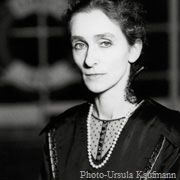 revolutionary inventor of dance theater had turned into a classic in the course of three decades, or that Bausch had reached the status of an √ľber-celebrity, considered by people in the know the most important choreographer of our time. (You can find my in-memoriam homage and an earlier review in these pages). revolutionary inventor of dance theater had turned into a classic in the course of three decades, or that Bausch had reached the status of an √ľber-celebrity, considered by people in the know the most important choreographer of our time. (You can find my in-memoriam homage and an earlier review in these pages).
Llke most Bausch pieces, Kontakthof has been repeat-performed regularly, testing its status and universal relevance. In 2000, Bausch showed a version of Kontakthof performed exclusively by lay seniors. You will have to go to the theater in Wuppertal to watch this tour de force in her archive: a film had been made by Lisel Mangelsdorf, "Meine Damen und Herren ab 65" (Ladies and Gentlemen above 65), but it is not in release. However, you can find clips on YouTube.
Almost 7 years later, at the end of 2006, Bausch made another experiment with Kontakthof: this time, she invited teenagers, students aged 14 to 18, from diverse schools in Wuppertal. None of them had any dance or theater background. It took these young non-performers a good year to do it, and film director Anne Linsel with her camera man Rainer Hoffmann were there from the start to document the hair-raising difficulties. Kids from upper class families, working class backgrounds and even a small band of brothers of Roma (gypsy) origin had to rub shoulders (and much more), trying to accomplish the most challenging task in any modern dance arena: becoming a Pina Bausch dancer.
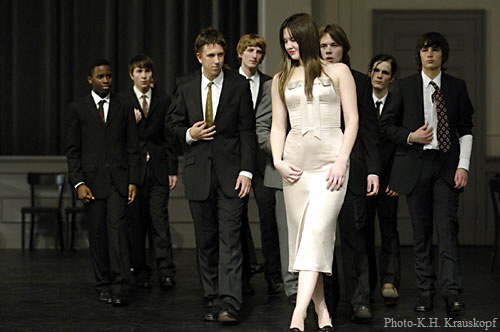 |
During Bausch's presentation of her first-ever creation on American soil, Nur Du / Only You, in Los Angeles and Berkeley, she told me one day: "It's not dance, but only a dancer can do it." A Bausch dancer has to overcome all inhibitions; move as he/she breathes; speak, sing, and emote like a first-class actor; turn extremely private and extremely disturbing feelings into bodily gesture and facial-vocal expression; let loose with total spontaneity and yet total self-control; be able to invent and create scenes in response to questions Pina asks; strip naked in every sense of the word.
Just what a normal schoolgirl or schoolboy can do, you will say!
Watching the process of selection and rehearsals is excruciating and funny, touching and filled with suspense. At first, the clumsy inhibition is almost general in the group of 40 teenagers, limbs and faces frozen by fear and embarrassment. The simplest thing, walking across a stage, is harder than skate-boarding or disco-dancing. Walking in a line with exaggerated hip kicks or in a circle with seductive glances and smiles almost kills them, especially when the song they are marching to goes, "Gn√§dige Frau, Sie sind ja so sch√∂n, da√ü ich mich nicht trau, Sie anzusehn…" (My esteemed Lady, you are so beautiful that I dare not look at you.) While some of the boys can do hiphop, one 15 year-old realizes, here you have to be both masculine and feminine. And you have to wear a suit and tie and shoes like a man around town – all of it new to most of the boys. The girls have to wear revealing dresses, very high heels to run on, and let themselves be touched, hugged, groped, fingered and handled by those attractive, dangerous aliens, the boys. Kontakthof in many ways is a very adult piece, an X-rated affair. Seeing teenagers struggle with it moves it once again to a very sensitive edge and reveals the continuous actuality of the piece. Who could have foretold that dance-lesson behaviors of the fifties (the era Bausch grew up in and referred to) would be avantgarde today? Part of the shock is the fact that we are watching the victims of the extreme sexualization of today's youth tell their own disturbing story through Pina Bausch's over 30 year-old images and scenes.
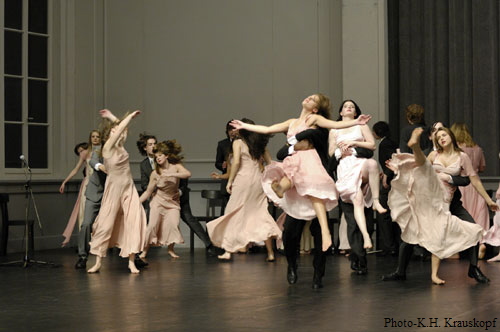 |
In order to do this, they had to grow up fast. Many of the girls and even some boys had never experienced being in love or being touched by the opposite sex. This may astonish, but teenagers dress and talk provocatively nowadays while they aren't any more liberated from shyness and shame or self-doubt as they were back then. Some of the most moving scenes in Tanzträume show the stunned, troubled, deeply feeling faces of those teens who are watching what the others are trying to do, risking their skin. "I can't РI can't do that!" is the most often heard reaction during the regular Saturday rehearsal sessions.
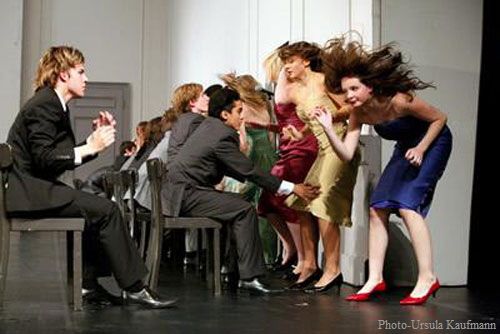 |
So why did they do it? Sure, it's easy to be tempted to get a star turn on a big stage, but not one of them had a clue about the challenges in store. Most of them had never heard about Pina Bausch. Luckily, they were in good hands with Jo Ann Endicott, the pudgy, sweet-faced dancer who back in 1978 created the main character and was Pina's female star for many years. She was helped by another ex-dancer, B√©n√©dicte Billet. Both know every single gesture inside out, and Endicott knows where you have to be inside yourself in order to bring it out, to bring it on. Her encouragement often saved the day in embarrassing scenes like the flirtation scene. A boy and a girl sit on a chair against the wall, separated by the whole room, gazing across the vast space at each other. With some nervousness, teasingly, tentatively, they take turns taking off one piece of clothing after another… In another scene, the most brutal of the piece, a girl has to remain impassive while the entire group of young men fondles her in increasingly violent ways. To the absurd song "Fr√ľhling und Sonnenschein bist du allein…" (You alone are springtime and sunshine) the spectator witnesses and feels the impact of a gang rape.
Even just running around in a circle in hysterical laughter proves to be an almost insurmountable challenge. The dancer, one of the gifted principals, a girl with a round, innocent face, thinks she can't do it. It can't be fake laughter, that would be too easy. It would lack power; it wouldn't be moving. It has to be real, i.e. really felt. Finally Jo Ann Endicott takes her by the hand and both take to running, driving up the craziness by just the right notch.
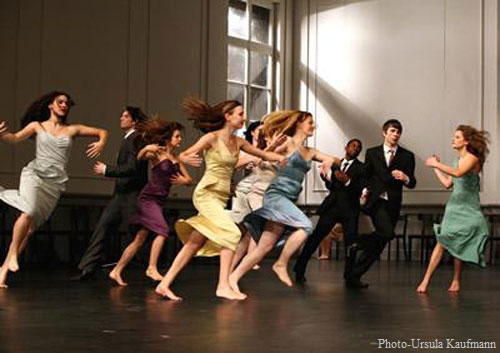 |
The team is lucky to have found a young stand-in for Endicott for the main role. She has a hint of a moody, angry teen fashion model, stalk-thin, with long blond hair, all edgy and utterly contemporary in her coolness and hidden vulnerability. It's the perfect look but she is exactly the opposite of what would make a spontaneous, uninhibited Bausch dancer, and her struggle – and ultimate glory -- gives a good idea of what working with Bausch must have been like for everybody in her group. Freedom doesn't come easy to anyone, perhaps the least to well-trained dancers. And it certainly doesn't make it any easier to meet the implacable gaze of the choreographer herself.
There she is, sitting behind her table, whispering her concerns to her assistants who are taking notes -- as one boy states, "with a poker face, smoking all the time and always looking at you… it 's a darn pressure, really." It's sometimes hard to say whether those deep-set, extraordinary eyes, now behind glasses, express despair or rejection or amused fascination. Watching Bausch's reactions is as suspenseful as watching the youngsters perform. Whenever a tiny smile curves her mouth and deepens the wrinkles around her eyes one feels a jolt: in this moment, perhaps, a star is born.
All the young people in this group of 40, divided into a first and second cast, are reborn in the process. The film beautifully captures their growing seriousness, the thinking that goes together with liberation and control. The transformation is amazing, to say it mildly. We see the same line-up of hip-kick walking in the final performance and don't believe our eyes. A day-and-night difference. The disbelief lingers as (at least from the memory of the original and repeated Kontakthof performances I have seen) the young version of Kontakthof does not miss one ounce of punch. The group has been molded and molded itself into the perfect instrument for the choreographer; each participant has mysteriously slipped into a Bausch dancer's skin. Nothing explains it, nothing except the enigma of Bausch's power as a person, teacher, creator. Another dream of dance come true.
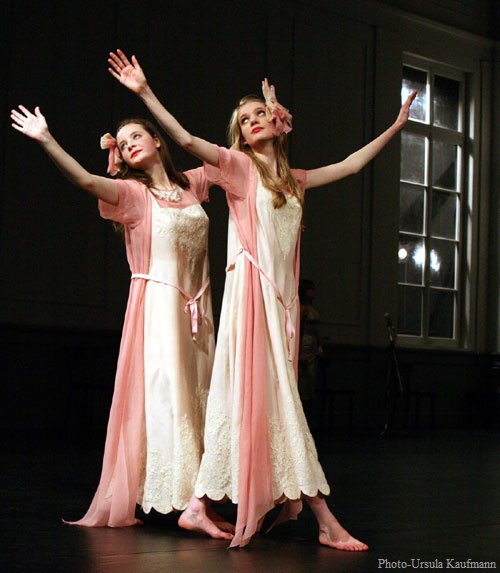 |
"I love them all," says the choreographer who was a legend almost from the start of her career. At the curtain call of the premiere, she walks the line, handing each dancer a rose, giving each one a personal word and a hug. The camera follows her as she turns a shy smile to the audience, lightly clapping her hands to applaud her young dancers, before the shadow of the curtain catches her and she has disappeared.
It's hard to shake the impact of the film, knowing that Pina Bausch is gone for good. I wanted to see the documentary again right away. Hooked by the Pina drug. But if this proves impossible (unless the pilgrimage to Wuppertal is undertaken), there is no reason for despair. The renowned German filmmaker Wim Wenders (Wings of Desire) has come back to the project he had planned for years and then abandoned when Bausch died just before filming was to begin. The ensemble and its new director, Bausch's long-term star dancer Dominique Merci, agreed to continue with the project. Wenders plans to use 3-D technology to give the audience the impression of moving right in the middle of the dancers. The film will be called Pina and released next year. It will be centered on three of her most potent early pieces, Caf√© M√ľller, Fr√ľhlingsopfer (Sacre du printemps), and Kontakthof.
A Taste of the Film
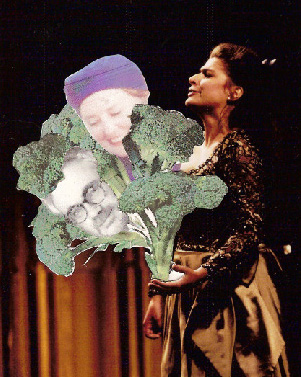
Alice Alice
Opera
On
Demand
Renate Stendhal
During my eight years with Scene4 I only once reviewed a cultural event that never occurred. I am talking about the opera Alice Alice, an opera about the American heroine Alice Waters, who brought the revolution of California Cuisine from Berkeley to America and set out to teach the nation's children to love green salads. This poignant new opera – in fact the first "green" opera -- with music by Berkeley composer John Adams (of Doctor Atomic fame) had everything a newly commissioned modern opera could wish for. Alice Alice had only one little flaw: I made it up.
Alice Alice was commissioned, executed and reviewed by me.
Perhaps I wanted to launch an idea?
To be honest (never too late), I don't know what got me. Put me on the couch and maybe I'll tell you more. Maybe I had seen just one too many annoying modern operas -- like Doctor Atomic, alas, reviewed in these pages. No doubt the urgent demand for Alice Alice had to be answered, on demand. I felt better after I provided this uplifting event. Maybe there was hope after all for modern American opera?
Everyone, especially opera connoisseurs and sophisticated editors, all wished they had seen it! Right now, after Jake Heggie's Moby-Dick, (alas, reviewed last month in these pages) you, too, will want to have seen it.
It's time to send a petition to Alice Waters and John Adams to get to work!
Originally Published April, 2006
At a recent dinner at Alice Water's Café, Chez Panisse, in Berkeley, California, I ran into a writer friend who told me that nobody wanted her latest novel so she had decided to self-publish it with Books on Demand. The element of wish fulfillment in this concept of book publishing got me dreaming. I had just seen John Adam's Doctor Atomic and couldn't resist the impulse to help the tottering movement of modern American opera along with a similar idea. Commissions are one thing (a thing of the present), but let's step into the future where no man has gone before Рinto the interactive, eminently democratic field of Opera On Demand. My dessert arrived Рa luscious layered chocolate cake. The first taste (like Proust's Madeleine) reminded me of the time, some years back, when Chez Panisse had taken all chocolate desserts off the menu... in order to educate patrons about their other, more sophisticated dessert offerings. In an instant it was clear to me that Alice Waters would be the ideal heroine of my first Opera On Demand Рand the ideal composer would of course be her fellow idealist, John Adams...
Alice Alice
After the wave of American historical tidbit operas (Nixon in China, The Death of Klinghoffer) and historical grand-ham operas (Doctor Atomic) it is time for something new. John Adams is taking a bold turn to the present with his contemporary eco-opera Alice Alice. Set in Berkeley, where the composer lives, the opera in progress is a loving portrait of California Nouvelle Cuisine inventor Alice Waters and the profound social changes this revolutionary has wrought in Berkeley and world-wide.
Adam's eco-opera will allegedly inaugurate San Francisco Opera's new director David Gockley's second San Francisco season (for the first one, in 2008-09, new opera commissions for Philip Glass and Stewart Wallace have already been announced).
A source close to the composer revealed that Alice Alice is "more than politically correct, it is pp – politically poignant." Scrapping the ouverture, the shock opening presents a multi-racial chorus, "There's no ghetto like our gourmet ghetto." With an edgy Broadway touch and solo segments the chorus tells the story of Alice's restaurants – Chez Panisse, Fanny's and C√©sar's, evoking the spirit of the era from the radical sixties to the opulent nineties. The orchestral setting is radical indeed in its complication. While a quartet of tenors wearing berets throw in humorous staccato accents in traditional French: "Baguette, Fromage de ch√®vre, Tarte Tatin, Marcel Pagnol, C√īte du Rh√īne, Vive la France, etc.", they are joined by a soprano and mezzo soprano who point to the happy marriage of Berkeley's radical traditions with Alice's pioneer spirit. The women's fractured rhythmic punctuations remind the audience with subtle irony of Berkeley inventions, "The Cheese Hoard Collective, The Edible Complex, People's Fork, Mario Savory, Free Speed, Make Lox Not War."
Then a quiet orchestral and electronic collage based on the chimes of the Campus Campanile accompanies a procession of Berkelytes in front of Chez Panisse. A crescendo builds up into the manic instrumental textures and metallic surfaces Adams is famous for, while skate boarders and nudists mix with Sather Gate prophets, Anti-Nuclear protestors, the homeless ("Free Lunch!") and dog walkers who cite in sprechgesang the city ordinance renaming dog owners "dog guardians". Out of the cacophony arises the single soprano voice of Alice W in an "Ode to Arugula."
But Act I does not end on this lyrical note. Conflict erupts when patrons hoisted on top of a car in Sproul Plaza demand chocolate desserts. Alice W lectures from the Sproul Hall steps about dessert consciousness, backed by a corona of chefs praising "Crème Brulée, Gooseberry Tart, Rhubarb Compote, and Lemon Sorbet." Alice W rises above Campus in a visionary cloud with an echo of the Bach cantata "Ich habe genug"( "I've had enough"). It is a composition that plays wittily with the kinship between "savor" and "savior." The patrons and demonstrators are brought to their knees.
Not many details are revealed yet about Act II. The commissioned libretto unites a collective of Bay Area writers Рauthors of bestsellers related to the themes of the opera (Lunch at the Café Ridiculous, What It's Like To Live Now, Bird By Bird, and perhaps most aptly, The Hungry Self). But at a recent press conference at the Berkeley landmark, Phoenix Pasticceria (where Alice W is known to supply herself with fresh pasta), a glimpse behind the curtain of mystery provided the following.
While the multi-racial chorus chops greens at kitchen tables in the back ("Chop-chop, chop-chop..."), Alice W enlightens three French chefs about the superiority of California Cuisine and its organic, orgasmic varieties of lettuces. The steamy quartet plays off Vivaldi's " Four Seasons" and culminates in a plea for a new Alice's restaurant in the Louvre. The tête à tête is brutally interrupted by card-carrying vegans confronting a group of vegetarians, and by demonstrators for "Grass-Fed Beef" shouting down marchers for "Grain-Fed Neiman Shell." An antiphonal choral in unresolved dissonance proclaims, "Grasslands, prairies for our cows!" "No blood for food!" "Cows in Berkeley? Mooo!" "Save the grass Рlet them eat cake!"
But Alice W saves the day with a choir of children dressed in garden aprons pledging allegiance to spinach. A touch of European connection is preserved through the silhouette of Prince Charles and Priscilla seen walking through a Berkeley school yard nibbling Alice W's school lunch from (recycled) paper cones. A discreet patriotic touch pervades the coda – an allusion to the National Anthem in counterpoint with Pachelbel's Canon as the children intone, "A green world, a healthy world, a broccoli world."
At the press conference, the composer was asked if there will be a love story in the new opera? Adams declined to give the plot away. But he promised a departure from his usual pessimistic Wagnerian endings. In a daring move toward the personal (which in Berkeley is still political), the character of the composer, John A, will join Alice W in serving up a humane vision to a larger, cultivated world by creating an eco-opera together. The cultivated opera-goer will undoubtedly recognize the orchestral quotations and relish the allusions to another famous pair of opera collaborators, Virgil Thomson and Gertrude Stein. Saint Teresa, the composer added with a sly smile, may appear dressed as a vegetable. He also revealed that he is working on a key dramatic scene of Alice W's notorious refusal to cook for the present White House. This very contemporary, politically charged scene will have Alice lounging at the bar of César's singing "I'm just a girl who can say no" backed by the patrons and waiters banging spoons against their glasses in counter-rhythm, "She Can say no, she Can say no!"
Adams admitted that a certain Berkeley writer pressured him to include a memento for another famous Alice (for whom, it is rumored, Alice W was named). Otherwise, this female member of the press corps insisted, the title of the opera – Alice Alice – would not make sense. She demanded that the full chorus, including the children, ought to quote the hash brownie recipe from the Alice B. Toklas Cookbook, accompanied by kettle drums and champagne flutes.
In case Adams backs out of the project (as has happened before with San Francisco commissioned operas), it is rumored that composers Ned Rorem and Steven Sondheim are standing by to step in. Opera On Demand is sure to serve America its first home-grown eco-opera.
|